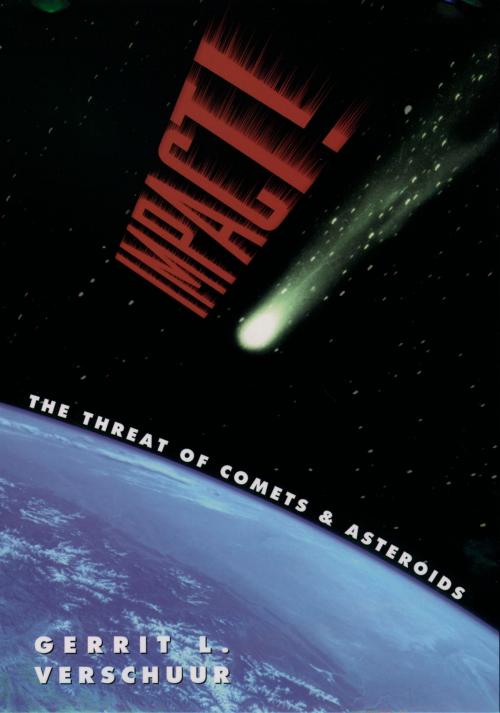| Author: | Gerrit L. Verschuur | ISBN: | 9780190283704 |
| Publisher: | Oxford University Press | Publication: | December 18, 1997 |
| Imprint: | Oxford University Press | Language: | English |
| Author: | Gerrit L. Verschuur |
| ISBN: | 9780190283704 |
| Publisher: | Oxford University Press |
| Publication: | December 18, 1997 |
| Imprint: | Oxford University Press |
| Language: | English |
Most scientists now agree that some sixty-five million years ago, an immense comet slammed into the Yucatan, detonating a blast twenty million times more powerful than the largest hydrogen bomb, punching a hole ten miles deep in the earth. Trillions of tons of rock were vaporized and launched into the atmosphere. For a thousand miles in all directions, vegetation burst into flames. There were tremendous blast waves, searing winds, showers of molten matter from the sky, earthquakes, and a terrible darkness that cut out sunlight for a year, enveloping the planet in freezing cold. Thousands of species of plants and animals were obliterated, including the dinosaurs, some of which may have become extinct in a matter of hours. In Impact, Gerrit L. Verschuur offers an eye-opening look at such catastrophic collisions with our planet. Perhaps more important, he paints an unsettling portrait of the possibility of new collisions with earth, exploring potential threats to our planet and describing what scientists are doing right now to prepare for this awful possibility. Every day something from space hits our planet, Verschuur reveals. In fact, about 10,000 tons of space debris fall to earth every year, mostly in meteoric form. The author recounts spectacular recent sightings, such as over Allende, Mexico, in 1969, when a fireball showered the region with four tons of fragments, and the twenty-six pound meteor that went through the trunk of a red Chevy Malibu in Peekskill, New York, in 1992 (the meteor was subsequently sold for $69,000 and the car itself fetched $10,000). But meteors are not the greatest threat to life on earth, the author points out. The major threats are asteroids and comets. The reader discovers that astronomers have located some 350 NEAs ("Near Earth Asteroids"), objects whose orbits cross the orbit of the earth, the largest of which are 1627 Ivar (6 kilometers wide) and 1580 Betula (8 kilometers). Indeed, we learn that in 1989, a bus-sized asteroid called Asclepius missed our planet by 650,000 kilometers (a mere six hours), and that in 1994 a sixty-foot object passed within 180,000 kilometers, half the distance to the moon. Comets, of course, are even more deadly. Verschuur provides a gripping description of the small comet that exploded in the atmosphere above the Tunguska River valley in Siberia, in 1908, in a blinding flash visible for several thousand miles (every tree within sixty miles of ground zero was flattened). He discusses Comet Swift-Tuttle--"the most dangerous object in the solar system"--a comet far larger than the one that killed off the dinosaurs, due to pass through earth's orbit in the year 2126. And he recounts the collision of Comet Shoemaker-Levy 9 with Jupiter in 1994, as some twenty cometary fragments struck the giant planet over the course of several days, casting titanic plumes out into space (when Fragment G hit, it outshone the planet on the infrared band, and left a dark area at the impact site larger than the Great Red Spot). In addition, the author describes the efforts of Spacewatch and other groups to locate NEAs, and evaluates the idea that comet and asteroid impacts have been an underrated factor in the evolution of life on earth. Astronomer Herbert Howe observed in 1897: "While there are not definite data to reason from, it is believed that an encounter with the nucleus of one of the largest comets is not to be desired." As Verschuur shows in Impact, we now have substantial data with which to support Howe's tongue-in-cheek remark. Whether discussing monumental tsunamis or the innumerable comets in the Solar System, this book will enthrall anyone curious about outer space, remarkable natural phenomenon, or the future of the planet earth.
Most scientists now agree that some sixty-five million years ago, an immense comet slammed into the Yucatan, detonating a blast twenty million times more powerful than the largest hydrogen bomb, punching a hole ten miles deep in the earth. Trillions of tons of rock were vaporized and launched into the atmosphere. For a thousand miles in all directions, vegetation burst into flames. There were tremendous blast waves, searing winds, showers of molten matter from the sky, earthquakes, and a terrible darkness that cut out sunlight for a year, enveloping the planet in freezing cold. Thousands of species of plants and animals were obliterated, including the dinosaurs, some of which may have become extinct in a matter of hours. In Impact, Gerrit L. Verschuur offers an eye-opening look at such catastrophic collisions with our planet. Perhaps more important, he paints an unsettling portrait of the possibility of new collisions with earth, exploring potential threats to our planet and describing what scientists are doing right now to prepare for this awful possibility. Every day something from space hits our planet, Verschuur reveals. In fact, about 10,000 tons of space debris fall to earth every year, mostly in meteoric form. The author recounts spectacular recent sightings, such as over Allende, Mexico, in 1969, when a fireball showered the region with four tons of fragments, and the twenty-six pound meteor that went through the trunk of a red Chevy Malibu in Peekskill, New York, in 1992 (the meteor was subsequently sold for $69,000 and the car itself fetched $10,000). But meteors are not the greatest threat to life on earth, the author points out. The major threats are asteroids and comets. The reader discovers that astronomers have located some 350 NEAs ("Near Earth Asteroids"), objects whose orbits cross the orbit of the earth, the largest of which are 1627 Ivar (6 kilometers wide) and 1580 Betula (8 kilometers). Indeed, we learn that in 1989, a bus-sized asteroid called Asclepius missed our planet by 650,000 kilometers (a mere six hours), and that in 1994 a sixty-foot object passed within 180,000 kilometers, half the distance to the moon. Comets, of course, are even more deadly. Verschuur provides a gripping description of the small comet that exploded in the atmosphere above the Tunguska River valley in Siberia, in 1908, in a blinding flash visible for several thousand miles (every tree within sixty miles of ground zero was flattened). He discusses Comet Swift-Tuttle--"the most dangerous object in the solar system"--a comet far larger than the one that killed off the dinosaurs, due to pass through earth's orbit in the year 2126. And he recounts the collision of Comet Shoemaker-Levy 9 with Jupiter in 1994, as some twenty cometary fragments struck the giant planet over the course of several days, casting titanic plumes out into space (when Fragment G hit, it outshone the planet on the infrared band, and left a dark area at the impact site larger than the Great Red Spot). In addition, the author describes the efforts of Spacewatch and other groups to locate NEAs, and evaluates the idea that comet and asteroid impacts have been an underrated factor in the evolution of life on earth. Astronomer Herbert Howe observed in 1897: "While there are not definite data to reason from, it is believed that an encounter with the nucleus of one of the largest comets is not to be desired." As Verschuur shows in Impact, we now have substantial data with which to support Howe's tongue-in-cheek remark. Whether discussing monumental tsunamis or the innumerable comets in the Solar System, this book will enthrall anyone curious about outer space, remarkable natural phenomenon, or the future of the planet earth.















